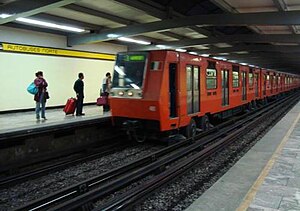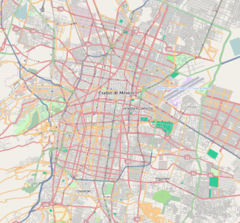Autobuses del Norte metro station
| STC rapid transit | ||||||||||||||||||||||||||||||||||||||||||||||||||||||||||||||||||||||||||||||||||||||||||||||||||||||||||
 An inbound NM-83 at the station | ||||||||||||||||||||||||||||||||||||||||||||||||||||||||||||||||||||||||||||||||||||||||||||||||||||||||||
| General information | ||||||||||||||||||||||||||||||||||||||||||||||||||||||||||||||||||||||||||||||||||||||||||||||||||||||||||
| Location | Eje Central Gustavo A. Madero, Mexico City Mexico | |||||||||||||||||||||||||||||||||||||||||||||||||||||||||||||||||||||||||||||||||||||||||||||||||||||||||
| Coordinates | 19°28′44″N 99°08′26″W / 19.478973°N 99.140668°W | |||||||||||||||||||||||||||||||||||||||||||||||||||||||||||||||||||||||||||||||||||||||||||||||||||||||||
| Owned by | Government of Mexico City | |||||||||||||||||||||||||||||||||||||||||||||||||||||||||||||||||||||||||||||||||||||||||||||||||||||||||
| Operated by | Sistema de Transporte Colectivo (STC) | |||||||||||||||||||||||||||||||||||||||||||||||||||||||||||||||||||||||||||||||||||||||||||||||||||||||||
| Line(s) | ||||||||||||||||||||||||||||||||||||||||||||||||||||||||||||||||||||||||||||||||||||||||||||||||||||||||||
| Platforms | 2 side platforms | |||||||||||||||||||||||||||||||||||||||||||||||||||||||||||||||||||||||||||||||||||||||||||||||||||||||||
| Tracks | 2 | |||||||||||||||||||||||||||||||||||||||||||||||||||||||||||||||||||||||||||||||||||||||||||||||||||||||||
| Connections |
| |||||||||||||||||||||||||||||||||||||||||||||||||||||||||||||||||||||||||||||||||||||||||||||||||||||||||
| Construction | ||||||||||||||||||||||||||||||||||||||||||||||||||||||||||||||||||||||||||||||||||||||||||||||||||||||||||
| Structure type | At grade | |||||||||||||||||||||||||||||||||||||||||||||||||||||||||||||||||||||||||||||||||||||||||||||||||||||||||
| Accessible | Partial | |||||||||||||||||||||||||||||||||||||||||||||||||||||||||||||||||||||||||||||||||||||||||||||||||||||||||
| Other information | ||||||||||||||||||||||||||||||||||||||||||||||||||||||||||||||||||||||||||||||||||||||||||||||||||||||||||
| Status | In service | |||||||||||||||||||||||||||||||||||||||||||||||||||||||||||||||||||||||||||||||||||||||||||||||||||||||||
| History | ||||||||||||||||||||||||||||||||||||||||||||||||||||||||||||||||||||||||||||||||||||||||||||||||||||||||||
| Opened | 30 August 1982 | |||||||||||||||||||||||||||||||||||||||||||||||||||||||||||||||||||||||||||||||||||||||||||||||||||||||||
| Passengers | ||||||||||||||||||||||||||||||||||||||||||||||||||||||||||||||||||||||||||||||||||||||||||||||||||||||||||
| 2023 | 6,974,950[1] | |||||||||||||||||||||||||||||||||||||||||||||||||||||||||||||||||||||||||||||||||||||||||||||||||||||||||
| Rank | 59/195[1] | |||||||||||||||||||||||||||||||||||||||||||||||||||||||||||||||||||||||||||||||||||||||||||||||||||||||||
| Services | ||||||||||||||||||||||||||||||||||||||||||||||||||||||||||||||||||||||||||||||||||||||||||||||||||||||||||
| ||||||||||||||||||||||||||||||||||||||||||||||||||||||||||||||||||||||||||||||||||||||||||||||||||||||||||
| ||||||||||||||||||||||||||||||||||||||||||||||||||||||||||||||||||||||||||||||||||||||||||||||||||||||||||
| ||||||||||||||||||||||||||||||||||||||||||||||||||||||||||||||||||||||||||||||||||||||||||||||||||||||||||
Autobuses del Norte metro station[a] is a Mexico City Metro station in Gustavo A. Madero, Mexico City. It is an at-grade station with two side platforms, served by Line 5 (the Yellow Line), between Instituto del Petróleo and La Raza stations. Autobuses del Norte station serves the colonias (neighborhoods) of Ampliación Panamericana and Capultitlan. The station's pictogram features the front of an intercity bus, and its name is on account of its proximity to Mexico City's Northern Bus Terminal. Autobuses del Norte metro station was opened on 30 August 1982, on the first day of the Politécnico–Pantitlán service. The station is partially accessible. In 2019, the station had an average daily ridership of 22,685 passengers, making it the 68th busiest station in the network and the third busiest of the line.
Location
[edit]Autobuses del Norte is a metro station located along Eje Central (in the section formerly known as 100 Metros Avenue), Gustavo A. Madero, northern Mexico City. The station serves the colonias (Mexican Spanish for "neighborhoods") of Ampliación Panamericana and Capultitlan. Within the system, the station lies between Instituto del Petróleo and La Raza stations.[3] Autobuses del Norte station serves the Northern Bus Terminal,[2] the largest bus terminal in the country.[4] The northern bus station's destinations include Acapulco, Guadalajara, Matamoros, Monterrey, San Miguel de Allende, and Tijuana, among others.[5] The area is also serviced by Line 1 (formerly Line A) of the trolleybus system,[2][3] by Route 15-A of the city's public bus system,[6] and by Routes 23 and 103 of the Red de Transporte de Pasajeros network.[7]
Exits
[edit]There are four exits:[3]
- East: Eje Central, Capultitlan.
- Northwest: Poniente 118 Street, Ampliación Panamericana.
- Southeast: Poniente 116 Street, Ampliación Panamericana.
- Southwest: Poniente 116 Street, Ampliación Panamericana.
History and construction
[edit]Line 5 of the Mexico City Metro was built by Cometro, a subsidiary of Empresas ICA,[8] and its last section was opened on 30 August 1982, operating from Pantitlán to Politécnico stations.[9][10] Autobuses del Norte metro station is located at grade;[11] the Autobuses del Norte–Instituto del Petróleo interstation is 1,067 meters (3,501 ft) long, while the Autobuses del Norte–La Raza section measures 975 meters (3,199 ft).[12] The station's pictogram represents the front view of an intercity bus.[3] The station is partially accessible to people with disabilities.[13]
In June 2006, Metro authorities replaced the railroad switches;[14] in 2008, they had maintenance work done on the station's roof.[15]
Ridership
[edit]According to the data provided by the authorities since the 2000s, and before the impact of the COVID-19 pandemic on public transport, commuters averaged per year between 22,400 and 24,800 daily entrances between 2013 and 2019; the station had a ridership of 8,280,147 passengers in 2019,[16] which was a decrease of 77,106 passengers compared to 2018.[17] Also in 2019, Autobuses del Norte metro station was the 68th busiest station of the system's 195 stations and it was the third busiest on Line 5.[16]
| Annual passenger ridership | |||||
|---|---|---|---|---|---|
| Year | Ridership | Average daily | Rank | % change | Ref. |
| 2023 | 6,974,950 | 19,109 | 59/195 | +11.92% | [1] |
| 2022 | 6,231,958 | 17,073 | 55/195 | +44.17% | [1] |
| 2021 | 4,322,667 | 11,842 | 69/195 | −3.47% | [18] |
| 2020 | 4,478,099 | 12,235 | 76/195 | −45.92% | [19] |
| 2019 | 8,280,147 | 22,685 | 68/195 | −0.92% | [16] |
| 2018 | 8,357,253 | 22,896 | 69/195 | +1.78% | [17] |
| 2017 | 8,211,462 | 22,497 | 69/195 | −5.42% | [20] |
| 2016 | 8,682,345 | 23,722 | 66/195 | +1.05% | [21] |
| 2015 | 8,591,750 | 23,539 | 65/195 | −0.53% | [22] |
| 2014 | 8,637,817 | 23,665 | 67/195 | −4.23% | [23] |
Gallery
[edit]-
Autobuses del Norte is located next to Eje Central, were trolleybuses (one pictured behind the Metro sign) also serve the area
-
Autobuses del Norte is located next to the Northern Bus Terminal (pictured)
Notes
[edit]- ^ Estación del Metro Autobuses del Norte. Spanish pronunciation: [awtoˈβuses ðel ˈnoɾte] . The name of the station literally means "Northern Buses" in Spanish and it is also known as "North Bus Station" in English.[2]
References
[edit]- ^ a b c d "Afluencia de estación por línea 2023" [Station traffic per line 2023] (in Spanish). Sistema Transporte Colectivo Metro. 2024. Archived from the original on 27 January 2024. Retrieved 24 January 2024.
- ^ a b c "Norte (North) Bus Station". Secretaría de Turismo de la Ciudad de México. Archived from the original on 6 March 2019. Retrieved 8 August 2020.
- ^ a b c d "Autobuses del Norte" (in Spanish). Sistema de Transporte Colectivo Metro. Archived from the original on 5 July 2020. Retrieved 8 August 2020.
- ^ "Getting There in Mexico City". Frommer's. Archived from the original on 10 November 2017. Retrieved 22 August 2020.
- ^ "Centro Histórico de la Ciudad de México – Cómo llegar" [Historic center of Mexico City – How to get there?] (in Spanish). Secretariat of Culture. Archived from the original on 31 January 2018. Retrieved 22 August 2020.
- ^ "Red de corredores" [Route network] (in Spanish). Retrieved 30 October 2021.
- ^ "Red de Rutas" [Routes network] (in Spanish). Red de Transporte de Pasajeros. Retrieved 30 October 2021.
- ^ "Línea 5, Ciudad de México" [Line 5, Mexico City] (in Spanish). iNGENET Infraestructura. 20 July 2009. Archived from the original on 2 September 2014. Retrieved 15 April 2020.
- ^ Pérez Cisneros, Tonatiuh (7 May 2018). ""El 8", el aterrador sitio del Metro Instituto del Petróleo" ["The 8", the scary location at Instituto del Petróleo metro station] (in Spanish). Reversos.mx. Archived from the original on 25 August 2020. Retrieved 23 August 2020.
- ^ Chávez García, Luis Alberto (1 June 2016). "Dip. Ana Juana Ángeles Valencia" [Deupty Ana Juana Ángeles Valencia] (PDF) (in Spanish). Legislative Assembly of Mexico City. p. 2. Archived (PDF) from the original on 25 August 2020. Retrieved 23 August 2020.
- ^ "Autobuses del Norte Metro Station (Mexico City, 1982)". Structurae.net. Archived from the original on 31 July 2020. Retrieved 8 August 2020.
- ^ "Longitud de estación a estación por línea" [Station-to-station length per line] (in Spanish). Sistema de Transporte Colectivo Metro. Archived from the original on 4 May 2021. Retrieved 12 July 2021.
- ^ "Mi Mapa Metro 22032021" [My Metro Map 22032021] (PDF) (in Spanish). Sistema Transporte Colectivo Metro. 22 March 2021. Retrieved 30 October 2021.
- ^ "Cerrarán el viernes tres estaciones de la línea 5 del Metro" [Three Line 5 stations will be closed next Friday]. La Jornada (in Spanish). 13 June 2006. Archived from the original on 25 August 2020. Retrieved 23 August 2020.
- ^ "Marzo 28 08" [March 28 08] (PDF). Mexico City Official Journal (in Spanish). 28 March 2008. p. 1. Retrieved 23 August 2020.
- ^ a b c "Afluencia de estación por línea 2019" [Station traffic per line 2019] (in Spanish). Sistema Transporte Colectivo Metro. 2020. Archived from the original on 3 July 2020. Retrieved 3 May 2020.
- ^ a b "Afluencia de estación por línea 2018" [Station traffic per line 2018] (in Spanish). Sistema Transporte Colectivo Metro. 2019. Archived from the original on 6 June 2019. Retrieved 7 April 2020.
- ^ "Afluencia de estación por línea 2021" [Station traffic per line 2021] (in Spanish). Sistema Transporte Colectivo Metro. 2022. Archived from the original on 7 March 2022. Retrieved 7 March 2022.
- ^ "Afluencia de estación por línea 2020" [Station traffic per line 2020] (in Spanish). Sistema Transporte Colectivo Metro. 2021. Archived from the original on 21 June 2021. Retrieved 21 June 2021.
- ^ "Afluencia de estación por línea 2017" [Station traffic per line 2017] (in Spanish). Sistema Transporte Colectivo Metro. 2019. Archived from the original on 3 May 2020. Retrieved 3 May 2020.
- ^ "Afluencia de estación por línea 2016" [Station traffic per line 2016] (in Spanish). Sistema Transporte Colectivo Metro. 2017. Archived from the original on 3 May 2020. Retrieved 3 May 2020.
- ^ "Afluencia de estación por línea 2015" [Station traffic per line 2015] (in Spanish). Sistema Transporte Colectivo Metro. 2016. Archived from the original on 3 May 2020. Retrieved 6 May 2020.
- ^ "Afluencia de estación por línea 2014" [Station traffic per line 2014] (in Spanish). Sistema Transporte Colectivo Metro. 2015. Archived from the original on 3 May 2020. Retrieved 6 May 2020.
External links
[edit] Media related to Autobuses Norte (station) at Wikimedia Commons
Media related to Autobuses Norte (station) at Wikimedia Commons- "Metro Autobuses del Norte". At the Official Guide to Mexico City.




